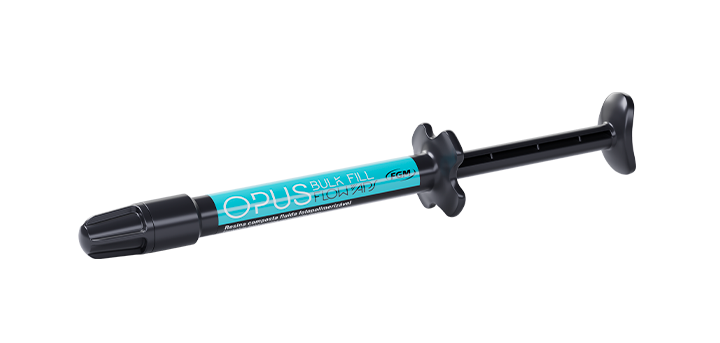Authors: Prof. Dr. Rodrigo S. Reis and Profª Dra. Michele A. Vivas
Since their introduction in the 1970s, composite resins have revolutionized restorative dentistry both in terms of esthetics and in reducing the degree of intervention involved in procedures. The materials have evolved over the decades in terms of mechanical and optical properties, and thus constitute the most versatile category of materials in restorative dentistry, combining esthetics, economic accessibility, and diverse possibilities, adapting to different methods, approaches, and professional profiles. Composite resins can be classified in several ways. One of the most traditionally employed methods has been according to size and distribution of particles (macro particles, micro particles, small particles, hybrids, microhybrids, nano particles, submicrometric particles). Based on the premise that from microhybrid, through nanohybrid to sub-micrometric particles we have similar mechanical properties, with varied degrees and longevity of gloss and polishing, in this text we will use a classification according to the degree of opacity, polymerization contraction, and consistency (putty or fluid) that are directly related to use in different clinical situations.
1. Double stratification systems::
A simple and accessible system, which offers interesting and satisfactory aesthetic results, indicated in all situations in which direct, indirect, and semi-direct restorations are recognized. Llis is a composite with a resin matrix composed of BIS-GMA, TEGDMA, BISEMA, and UDMA, barium, boron, aluminosilicate glass filler of average size 0.7μm in the amount of 77.5 to 78.5% in weight (56 to 59% in volume) and 16 shades.
1.2 Multiple stratification system: Dentin opacity I Enamel I Achromatic enamel I Effect
In this category, in addition to the enamel and dentin resins described above, we have a wider variety of translucent resins (achromatic enamels, with a translucent effect), resins with a high opacity effect (blocking) of unwanted pigmentation and shades for whitened teeth. With proven success for almost two decades, Opallis is a composite with a resin matrix composed of BIS-GMA, TEGDMA, BISEMA, and UDMA, barium glass filler, boron, aluminosilicate of average size of 0.7μm in the amount of 78.5 to 79.8% in weight (57 to 59% in volume), with an average particle size of 0.5μm and 34 shades, and it is one of the most versatile systems on the market, and meeting the most basic to the most complex requirements.
Vittra APS represents a true technological innovation for the most modern highly aesthetic composites. Its resin matrix based on modified urethane dimethacrylate resins and free of bisphenols, makes the material a pioneer in the proposal of being BPA-Free, that is, free of BPA. In addition to a modern and exclusive photoinitiator system (APS), with reduced camphorquinone content, which brought a series of benefits to the material, such as: 4x more working time, better conversion rate and predictability of results, with no noticeable shade difference after polymerization. Regarding the filler particles, Vittra APS uses spheroidal zirconia silicate of 0.2μm (submicrometric) in a content of 72 to 82% in weight and 52 to 60% in volume. This particle technology allows for quick and differentiated polishing and maintenance of gloss for longer periods, requiring less repolishing than composites with larger particles and irregular shapes. Therefore, Vittra APS can be used in both simplified double stratifications and complex stratifications, meeting the simplest to the most complex aesthetic challenges.
2-Single opacity layering systems
2.1 Body
Body opacity means a simplified and intermediate opacity between dentin and enamel, and can be used as a single putty (in incremental technique) that is suitable for resolving the vast majority of everyday cases. The use of only one type of opacity simplifies the technique and reduces the risk of errors due to lack of control over enamel and dentin thickness, precisely because the body resin has an intermediate opacity without being so opaque or so translucent.
Elóra APS is a medium opacity composite system with a resin matrix based on BISGMA, TEGDMA, BISEMA, and UDMA with zirconium silicate particles and barium glass of average size 0.49μm. This blend provides distinctive and clinically impressive gloss and polish. Elóra APS has an APS photoinitiator system and all its benefits previously described, that is, a simplification of the technique with a high level of esthetics in both single and eventually double layering.
These are systems with a proposal for maximum simplification, that is, a single syringe of medium opacity resin and without pigments, which has the capacity to mirror the shades of the surrounding walls of the cavity preparation and reproduce different shades in a simple and effective way. In everyday life, this type of material works very well and makes the difficult step of shade selection unnecessary. In this category, we have Vittra APS Unique which, in addition to all the benefits of the APS system, is a BPA-Free material, that is, its resin matrix of urethane methacrylates is free of bisphenols and has a loading close to 80% in weight (60% in volume) based on boronaluminosilicate glass.
Tip: A great advantage of Vittra APS Unique resin is the use of restorations required prior to dental whitening, as it has the potential to “whiten” along with the teeth, due to the fact that it mirrors the shades of the surrounding dental walls.
2.3 Bulk Fill
Since traditional resins have a tension generated by clinically relevant contraction, to the point of generating problems such as postoperative sensitivity, GAPs in posterior teeth, and limited polymerization depth (average of 2 mm), “Bulk-Fill” type resins were developed to reduce this risk and increase productivity (use of larger increments). In general, they present the characteristics of lower polymerization contraction than conventional ones, and mainly, lower tension generated by this, in addition to greater translucency than conventional body resins, allowing greater passage of light. Particles of slightly larger average size since very small particles cause greater dispersion of the light beam during photoactivation. With this, increments of 4 to 5 mm can be used without worrying about harmful effects of polymerization contraction, and even so have a well polymerized material (respecting – the indicated time and having a good device photoactivator). Polishing is suitable for posterior segment (similar to older resins such as the first micro hybrids) and a slightly more translucent appearance. Some manufacturers present single-color resins and others come in a small variety of colors.
Opus Bulk Fill APS is a urete-based resin with 79% inorganic filler by weight, indicated for direct posterior restorations. Minimizes risks inherent to polymerization contraction and gain in clinical productivity, with adequate esthetics for the posterior segment. This material has as a photoinitiator the APS system and enjoys all its benefits. It is very important to avoid the longer working time of Opus Bulk Fill APS in a well-lit operating field, since in the Bulk Fill technique we fill the cavity with the material (respecting the 5mm depth limits of each increment) and we perform the subtractive sculpture. Do this with the illuminated field, with a material who has long working hours, without the risk of premature polymerization, makes the work easier, minimizing the risk of leaving excesses.
3. Flow Resin Systems
They are resin systems with lower viscosity that can be injected. This category has gone through several evolutionary states. In the beginning, in the 1990s, these were materials with low load content (30 to 50% in weight) and without good thixotropy (which could flow much further than desired), being limited to the use of a thin layer of internal lining, sealing of grooves and fissures, small cavities without masticatory stress. After undergoing significant improvements, today we have a wide variety of Flow type resins, most recently with high load content, high thixotropy and flowing only when desired (“Full Control”) and high polishing for injected and mixed guided resin techniques.
Vittra APS Unique Flow is a unichroma tic fluid resin with a true chameleon effect, with the same properties and characteristics described for Vittra APS Unique but in a fluid consistency with good thixotropy (without excessive flow), in addition to being BPA Free (free of bisphenols). Besides all the indications of a flow, it works well on small and medium cervical lesions and is an incomparable material for making “attachments” for orthodontic aligners. It has a loading percentage of 58% to 62% in weight
Opallis Flow is an injectable resin system with a high percentage of filler, between 70 to 74% in weight, based on barium, boron, aluminosilicate, with sizes between 0.5 to 1μm and silanized silicon dioxide. Its resin matrix is similar to that of traditional Opallis resin, but with lower viscosity (greater fluidity).
Opus Bulk Fill Flow APS is a low-shrinkage, low-polymerization- tension flow resin system indicated for bases in posterior restorations (dentin substitutes covered by a bulk restorative resin), in addition to small fillings and other indications for a traditional flow resin. This material has all the benefits of the APS system and a thixotropic self-leveling capacity, reducing the risk of undesirable flow. It should be used in increments of up to 4mm to obtain an adequate degree of conversion. It has approximately 68% loading in weight.
Vittra APS Flow brings together the features of the most modern flowable or injectable resins. In addition to all the characteristics similar to Vittra APS resin, Vittra APS Flow has a remarkable and differentiated thixotropy. Once injected, they remain “immobile,” flowing only under pressure or with stimulation from an instrument or brush (Full Control flow according to demand). In addition to having a loading percentage of 67% to 70% in weight. Its use is perfect, without the risk of bubbles from compacting resins in bulk and its thixotropy allows for a carving that leaves the margins practically without excess (a difficulty with flow resins in general). Vittra APS Flow is also recommended for injected or mixed guided techniques. Just like Vittra APS, its polishing and gloss are very different, making it widely used in restorative dentistry
Over its 29 years, FGM has developed expertise in the area of dental composites, ranging from basic to complex restorations, standing out with innovations in photoactivation systems and shade mirroring systems (chameleon/unichromatic), with a variety of products for each professional profile and for all different clinical challenges, whether in direct, semi-direct, or indirect restorations.

































